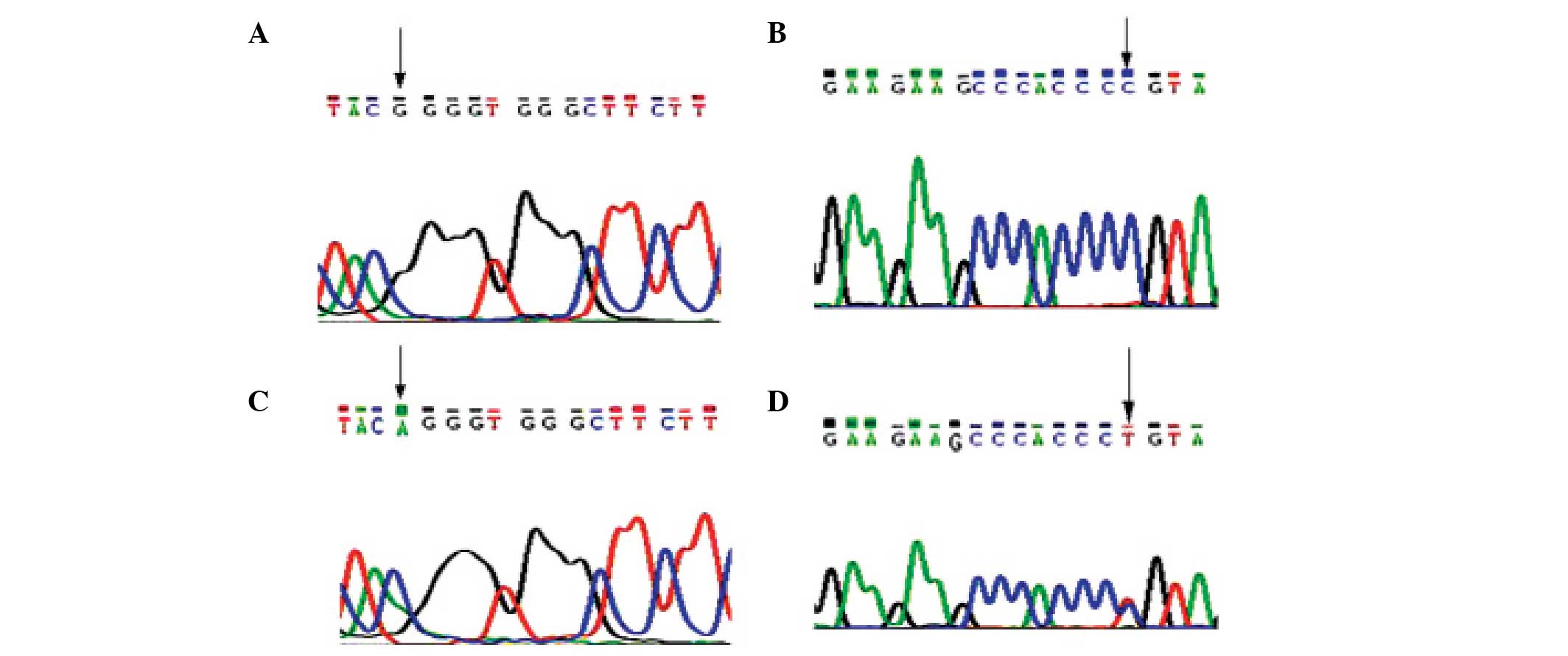|
1
|
Placone J and Hristova K: Direct
assessment of the effect of the Gly380Arg achondroplasia mutation
on FGFR3 dimerization using quantitative imaging FRET. PLoS One.
7:e466782012. View Article : Google Scholar : PubMed/NCBI
|
|
2
|
Orioli IM, Castilla EE and Barbosa-Neto
JG: The birth prevalence rates for the skeletal dysplasias. J Med
Genet. 23:328–332. 1986. View Article : Google Scholar : PubMed/NCBI
|
|
3
|
Horton WA, Hall JG and Hecht JT:
Achondroplasia. Lancet. 370:162–172. 2007. View Article : Google Scholar : PubMed/NCBI
|
|
4
|
Su N, Xu X, Li C, et al: Generation of
Fgfr3 conditional knockout mice. Int J Biol Sci. 6:327–332. 2010.
View Article : Google Scholar : PubMed/NCBI
|
|
5
|
Shiang R, Thompson LM, Zhu YZ, et al:
Mutations in the transmembrane domain of FGFR3 cause the most
common genetic form of dwarfism, achondroplasia. Cell. 78:335–342.
1994. View Article : Google Scholar : PubMed/NCBI
|
|
6
|
Rousseau F, Bonaventure J, Legeai-Mallet
L, et al: Mutations in the gene encoding fibroblast growth factor
receptor-3 in achondroplasia. Nature. 371:252–254. 1994. View Article : Google Scholar : PubMed/NCBI
|
|
7
|
Li YQ, Li QL and Zhang MH: Comparison of
diagnostic value of growth hormone exercise test and growth hormone
provocative test on growth hormone deficiency. J Appl Clin Pediatr.
24:601–602. 2009.
|
|
8
|
Francomano CA, Ortiz de Luna RI, Hefferon
TW, et al: Localization of the achondroplasia gene to the distal 2.
5Mb of human chromosome 4p. Hum Mol Genet. 3:787–792. 1994.
View Article : Google Scholar : PubMed/NCBI
|
|
9
|
He X, Xie F and Ren ZR: Rapid detection of
G1138A and G1138C mutations of the FGFR3 gene in patients with
achondroplasia using high-resolution melting analysis. Genet Test
Mol Biomarkers. 16:297–301. 2012. View Article : Google Scholar : PubMed/NCBI
|
|
10
|
Pehlivan S, Ozkinay F, Okutman O, et al:
Achondroplasia in Turkey is defined by recurrent G380R mutation of
the FGFR3 gene. Turk J Pediatr. 45:99–101. 2003.PubMed/NCBI
|
|
11
|
Cui Y, Zhao H, Liu Z, Liu C, Luan J, Zhou
X and Han J: A systematic review of genetic skeletal disorders
reported in Chinese biomedical journals between 1978 and 2012.
Orphanet J Rare Dis. 7:552012. View Article : Google Scholar : PubMed/NCBI
|
|
12
|
Superti-Furga A, Eich G, Bucher HU, Wisser
J, Giedion A, Gitzelmann R and Steinmann B: A glycine
375-to-cysteine substitution in the transmembrane domain of the
fibroblast growth factor receptor-3 in a new born with
achondroplasia. Eur J Pediatr. 154:215–219. 1995. View Article : Google Scholar : PubMed/NCBI
|
|
13
|
Prinos P, Kilpatrick MW and Tsipouras P: A
novel G346E mutation in achondroplasia. Pediatr Res.
37:151A1994.
|
|
14
|
Zhang SR, Zhou XQ, Ren X, et al: Ser217Cys
mutation in the Ig II domain of FGFR3 in a Chinese family with
autosomal dominant achondroplasia. Chin Med J (Engl).
120:1017–1019. 2007.PubMed/NCBI
|
|
15
|
Coutts JC and Gallagher JT: Receptors for
fibroblast growth factors. Immunol Cell Biol. 73:584–589. 1995.
View Article : Google Scholar : PubMed/NCBI
|
|
16
|
Mohammadi M, Dikic I, Sorokin A, Burgess
WH, Jaye M and Schlessinger J: Identification of six novel
autophosphorylation sites on fibroblast growth factor receptor 1
and elucidation of their importance in receptor activation and
signal transduction. Mol Cell Biol. 16:977–989. 1996.PubMed/NCBI
|
|
17
|
Webster MK and Donoghue DJ: Constitutive
activation of fibroblast growth factor receptor 3 by the
transmembrane domain point mutation found in achondroplasia. EMBO
J. 15:520–527. 1996.PubMed/NCBI
|
|
18
|
Naski MC, Wang Q, Xu J and Ornitz DM:
Graded activation of fibroblast growth factor receptor 3 by
mutations causing achondroplasia and thanatophoric dysplasia. Nat
Genet. 13:233–237. 1996. View Article : Google Scholar : PubMed/NCBI
|
|
19
|
Matsushita T, Wilcox WR, Chan YY, et al:
The FGFR3 promotes synchondrosis closure and fusion of ossification
centers through the MAPK pathway. Hum Mol Genet. 18:227–240. 2009.
View Article : Google Scholar : PubMed/NCBI
|
|
20
|
Tanaka N, Katsumata N, Horikawa R and
Tanaka T: The comparison of the effects of short-term growth
hormone treatment in patients with achondroplasia and with
hypochondroplasia. Endocr J. 50:69–75. 2003. View Article : Google Scholar : PubMed/NCBI
|
|
21
|
Tanaka H, Kubo T, Yamate T, Ono T, Kanzaki
S and Seino Y: Effect of growth hormone therapy in children with
achondroplasia: growth pattern, hypothalamic-pituitary function,
and genotype. Eur J Endocrinol. 138:275–280. 1998. View Article : Google Scholar : PubMed/NCBI
|
|
22
|
Ramaswami U, Rumsby G, Spoudeas HA,
Hindmarsh PC and Brook CG: Treatment of achondroplasia with growth
hormone: six years of experience. Pediatr Res. 46:435–439. 1999.
View Article : Google Scholar : PubMed/NCBI
|
|
23
|
Yamate T, Kanzaki S, Tanaka H, et al:
Growth hormone (GH) treatment in achondroplasia. J Pediatr
Endocrinol. 6:45–52. 1993. View Article : Google Scholar : PubMed/NCBI
|
|
24
|
Escamilla RF, Hutchings JJ, Li CH and
Forsham P: Achondroplastic dwarfism Effects of treatment with human
growth hormone. Calif Med. 105:104–110. 1996.
|
|
25
|
Seino Y, Yamanaka Y, Shinohara M, et al:
Growth hormone therapy in achondroplasia. Horm Res. 53:53–56. 2000.
View Article : Google Scholar : PubMed/NCBI
|
|
26
|
Wilkin DJ, Szabo JK, Cameron R, et al:
Mutations in fibroblast growth factor receptor 3 in sporadic cases
of achondroplasia occur exclusively on the paternally derived
chromosome. Am J Hum Genet. 63:711–716. 1998. View Article : Google Scholar : PubMed/NCBI
|












